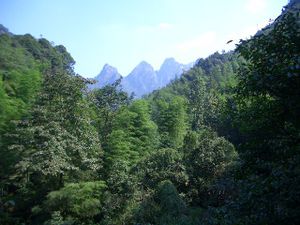Lin2Value
| Line 1: | Line 1: | ||
| − | [[file:welcomepine.jpg|thumb| | + | [[file:welcomepine.jpg|thumb|200px|right]] |
*'''Funding:''' BMBF | *'''Funding:''' BMBF | ||
| Line 10: | Line 10: | ||
With an extensive land area, China has significant potential for carbon sequestration to mitigate climate change. This can be accomplished by improving forest management to increase the quantity and quality of the biomass in existing forests in addition to expanding forest area. The role that Chinese forests can play in combating climate change is therefore of global significance.The scientific and technical cooperation in forestry between Germany and China has a long history and continues to be promoted. This project is motivated by their common interest and efforts to establish multi-functional forestry and adapt forest management strategies to climate change. For example, “close to nature forestry” is implemented as the guiding silvicultural principle in the German Federal State of Lower Saxony (Partner State of Anhui Province, and its forest ad-ministration is an associated partner of this project) since 1990 and also in a few Chinese provinces. | With an extensive land area, China has significant potential for carbon sequestration to mitigate climate change. This can be accomplished by improving forest management to increase the quantity and quality of the biomass in existing forests in addition to expanding forest area. The role that Chinese forests can play in combating climate change is therefore of global significance.The scientific and technical cooperation in forestry between Germany and China has a long history and continues to be promoted. This project is motivated by their common interest and efforts to establish multi-functional forestry and adapt forest management strategies to climate change. For example, “close to nature forestry” is implemented as the guiding silvicultural principle in the German Federal State of Lower Saxony (Partner State of Anhui Province, and its forest ad-ministration is an associated partner of this project) since 1990 and also in a few Chinese provinces. | ||
| − | [[file: | + | [[file:forest.jpg|thumb|300px|right]] |
==Project Goals== | ==Project Goals== | ||
Revision as of 12:06, 8 November 2012
- Funding: BMBF
- Duration: 2012-2015
- Link: www.lin2value.de
- Coordination: Prof. Dr. Christoph Kleinn, Sabine Schreiner
Contents |
Background
China has established more than 50 million ha of forests in the last 30 years, equivalent to 1/4 of all global afforestation during this period.However, the condition of many of these forests is not optimal, especially in the subtropical regions of China, due to different limiting factors. Thus, they likely do not optimally provide environmental services such as water and soil protection. With an extensive land area, China has significant potential for carbon sequestration to mitigate climate change. This can be accomplished by improving forest management to increase the quantity and quality of the biomass in existing forests in addition to expanding forest area. The role that Chinese forests can play in combating climate change is therefore of global significance.The scientific and technical cooperation in forestry between Germany and China has a long history and continues to be promoted. This project is motivated by their common interest and efforts to establish multi-functional forestry and adapt forest management strategies to climate change. For example, “close to nature forestry” is implemented as the guiding silvicultural principle in the German Federal State of Lower Saxony (Partner State of Anhui Province, and its forest ad-ministration is an associated partner of this project) since 1990 and also in a few Chinese provinces.
Project Goals
The objective is to develop and analyze new technologies and innovative methodological approaches for strategic improvement of the management, harvesting and utilization of young and middle aged plantation forests in subtropical regions of China in the context of land use improvement under climate change, and to contribute to the establishment of a global partnership for development and environmental sustainability by focusing on the sustainable scientific dialog between Germany and China.
Work plan
The joint project consisting of 2 subprojects Lin4Carbon (1) and Lin4Wood (2) is subdivided into 10 work packages (WPs) in order to ensure achievement of project objectives. Each WP has a focus. However, there is a clear inherent linkage among WPs, especially those in the same subproject. In general, Chinese and German partners will work collaboratively within each WP.
Partners
German project partners:
- Georg-August-Universität Göttingen (UoG)
- Albert-Ludwigs-Universität Freiburg (UoF)
- Technische Universität Dresden (TUD)
Chinese project partners:
- Chinese Academy of Forestry (CAF)
- International Center for Bamboo and Rattan (ICBR)
Project associated partners:
- Niedersächsische Landesforsten (NLF)
- State Forestry Administration, China (SFA)
- Unique Forestry and Land Use GmbH
- ARGUS Forstplanung
- China National Bamboo Research Center (CBRC)
- Experimental Center of Tropical Forestry (ECTF)
- Forestry Department of Anhui Province

